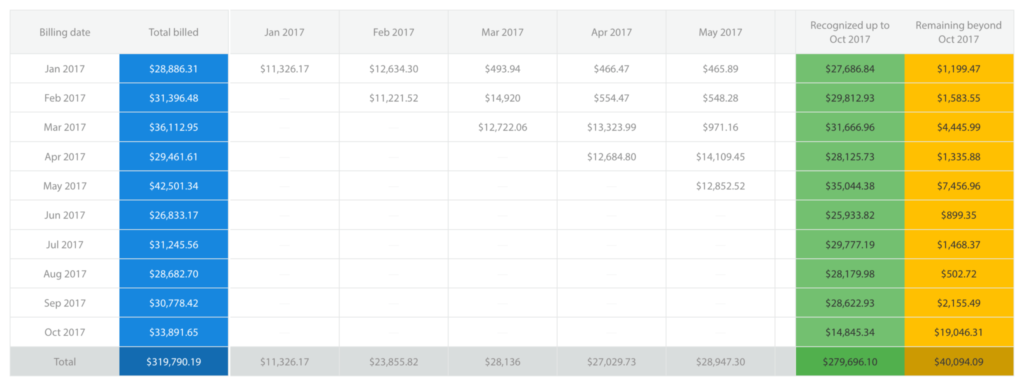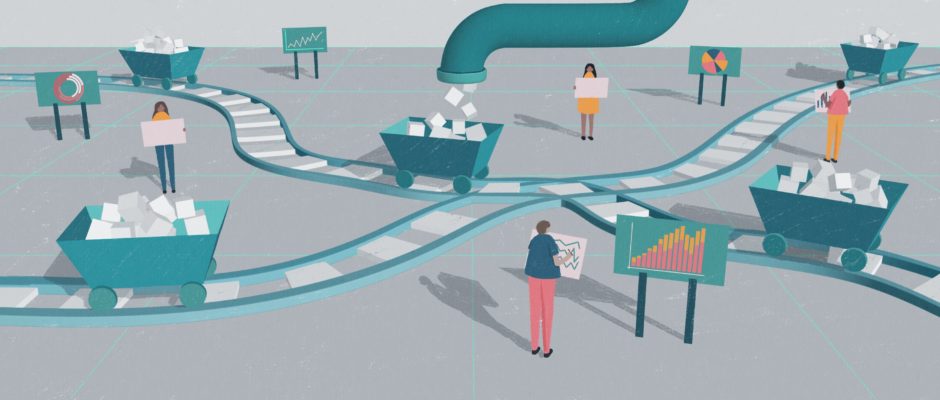Repeat after me: cash is not revenue!
There are a set of rules and guidelines focused around how businesses calculate and recognize revenue, and if you report earnings to investors or other business stakeholders, they’ll want to see this. Revenue recognition is a critical piece of accounting for any business.
For a SaaS or subscription business, revenue recognition can be complex, mainly because of the service-oriented nature of the product. While your customers may pay you a lump sum upfront for a year’s worth of usage, you won’t be able to categorize that entire amount of cash as revenue right away.
Definition: what is revenue recognition?
Revenue recognition is the process of converting bookings (and the subsequent cash from those bookings) into revenue within your business.
Key terminology
- GAAP (Generally Accepted Accounting Principles) — Vary by country but most people refer to US GAAP.
- FASB (Financial Accounting Standards Board) — A Standard setting body that issues guidelines.
- ASC 606 – Accounting Standards Codification related to revenue recognition.
- Balance sheet (has two sides) — one side reflects assets, the other liabilities & equity.
- Income statement — reflects the results of a period by showing revenue and expenses a company incurred.
- Recognized Revenue — commonly referred to as just “revenue” and reflected in the income statement. Payments that fulfill five criteria (see below) can be considered recognized revenue.
- Deferred Revenue — relates to payments that have been received by the company, but for which goods or services have not yet been provided. It is reflected as a liability on the balance sheet because the company is still liable to provide these goods or services.
ASC 606 & IFRS 15
“The new revenue standard will significantly affect the revenue recognition practices of most companies. The new standard provides a comprehensive, industry-neutral revenue recognition model intended to increase financial statement comparability across companies and industries.”
PwC
ASC 606 and IFRS 15 are standards jointly issued by The Financial Accounting Standards Board and the International Accounting Standards Board. The goal of these standards is to smooth over how contracted revenue is recognized across industries and around the world.
“The new guidance affects any reporting organization that either enters into contracts with customers to transfer goods or services or enters into contracts for the transfer of nonfinancial assets unless those contracts are within the scope of other standards”
Financial Standards Accounting Board (FASB)
The good news for SaaS and subscription businesses is that they actually simplify and unify a lot of the obligations for revenue recognition, where it was previously lacking consistency. But the new standards may require an overhaul of your company’s financial reporting processes.
“While SaaS entities may not expect the new revenue standard to affect them as much as other entities, the experiences of public SaaS entities in the past year has shown they should not underestimate its impact.”
Deloitte
Why is revenue recognition important?
The bottom line here is that compliance with the above standards is not optional. The consequences of non-compliance can be severe. You should always fulfill your company’s reporting obligations. The good news however, is that you can take a smart approach when it comes to automating these processes. Depending on the size of your business and the nature of your services — e.g. with a mixture of monthly and annual deals — recognizing revenue can get pretty complex. Automating the creation of deferred and recognized revenue schedule can help save time, reduce complexity and any potential for human error.
The guiding principles of revenue recognition under ASC 606
1. Identify the contract with the customer
Customer contracts are reasonably straightforward for SaaS businesses — the cost and value exchange is defined upfront on the website, and there’s little deviance from the pre-defined structure. There’s one complexity here though: In the subscription world, the terms of a contract can change frequently. This includes:
- When a customer upgrades (expands) their subscription
- When a customer downgrades (contracts) their subscription
- When an add-on is purchased, e.g. additional seats
These changes could mean creation of a separate contract, but in many cases it’s just a modification of the original.
2. Identify the performance obligations in the contract
The term “performance obligations” may seem overly vague at first, but it basically just refers to the product (or service) you’re actually delivering to the customer, i.e. what are they getting for their money? The answer is most likely “a month’s worth of access to my service.”
3. Determine the transaction price
With the exception of some custom enterprise deals, the price of most SaaS contracts is a known quantity — it’s clearly defined upfront (on the pricing page). When we talk about transaction price here, we’re always talking about the net price.
4. Allocate the transaction price to separate performance obligations
For SaaS, the product is delivered continually (“as a service”). This means that there aren’t really separate performance obligations — rather one continuous performance obligation.
What we do here is allocate a share of the billing value to each month that contains at least some part of the service period. The share of the value assigned to a month equals the share of the billing period that falls into this month.
5. Recognize revenue as each performance obligation is satisfied
There are actually five criteria for recognizing revenue as per ASC 606. If the prerequisites are not all met, you cannot recognize the billings as revenue.
- Risks and rewards have been transferred from the seller to the buyer
- The seller has no control over the goods sold
- The collection of payment is reasonably assured
- The amount of revenue can be reasonably measured
- The costs of earning the revenue can be reasonably measured
Tracking and analyzing recognized revenue
While most businesses will likely start out with a basic spreadsheet, there are a number of ways you can track revenue recognition that go beyond simple tables, and help make the connection between cashflow and revenue.
A revenue waterfall is useful to see how billing amounts turn into revenue over time. Due to different billing cycles, payment terms and other complexities, the amount billed in a single month may not all be recognized as revenue until some months later. The revenue waterfall visualizes the billing volume top to bottom and recognized revenue by month from left to right. The two dimensions of the revenue waterfall table connect billing and revenue so that you can get a clear picture of how each months’ billings are translated into recognized revenue over time:

Resources and Further Reading
DOWNLOADABLES
The new revenue recognition standard [PDF] (EY)
BASICS
The complete guide to SaaS revenue recognition with ASC 606 (ChartMogul) — Includes more detail on many of the concepts discussed here.
ASC 606 — Revenue From Contracts With Customers (Deloitte)
Revenue from contracts with customers (PWC)
Handbook: Revenue for software and SaaS (KPMG)
DEEP CUTS
Investor perspectives on ASC 606 for software and SaaS [PDF] – KPMG
